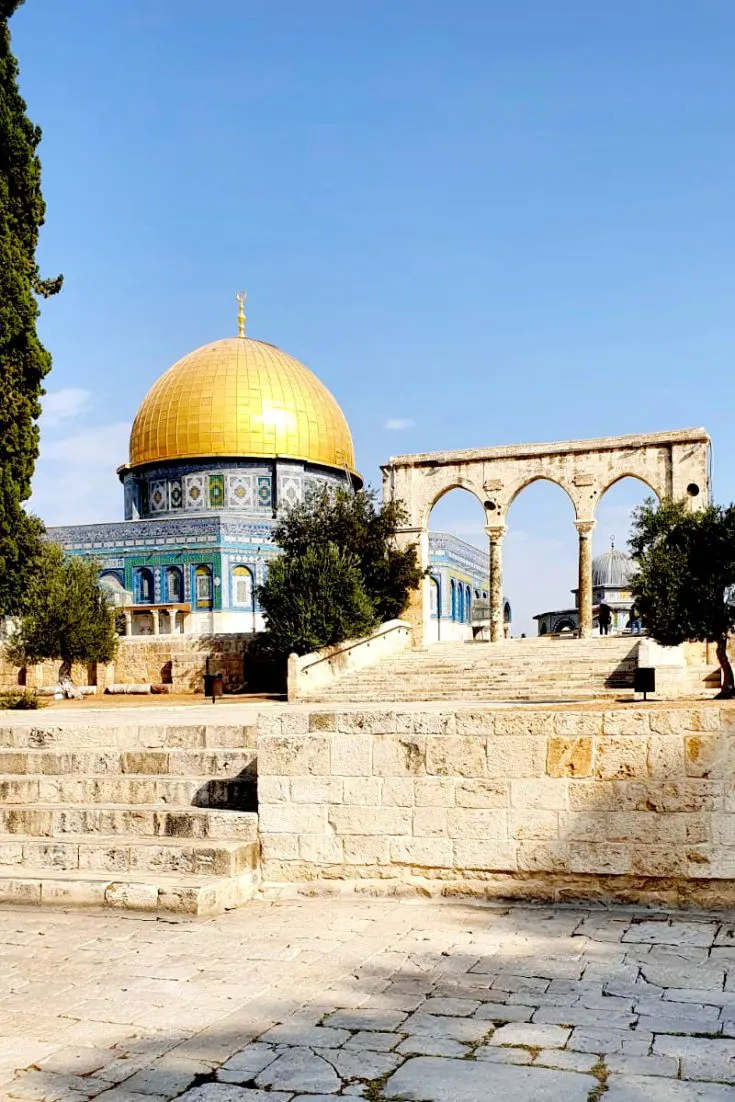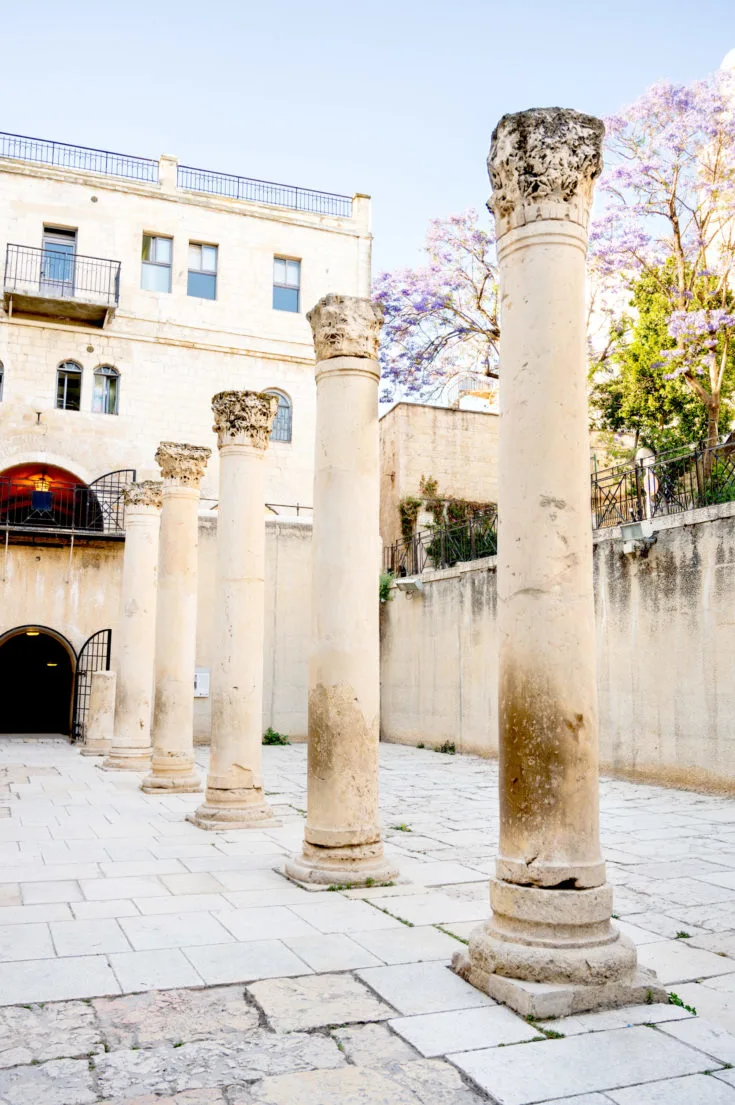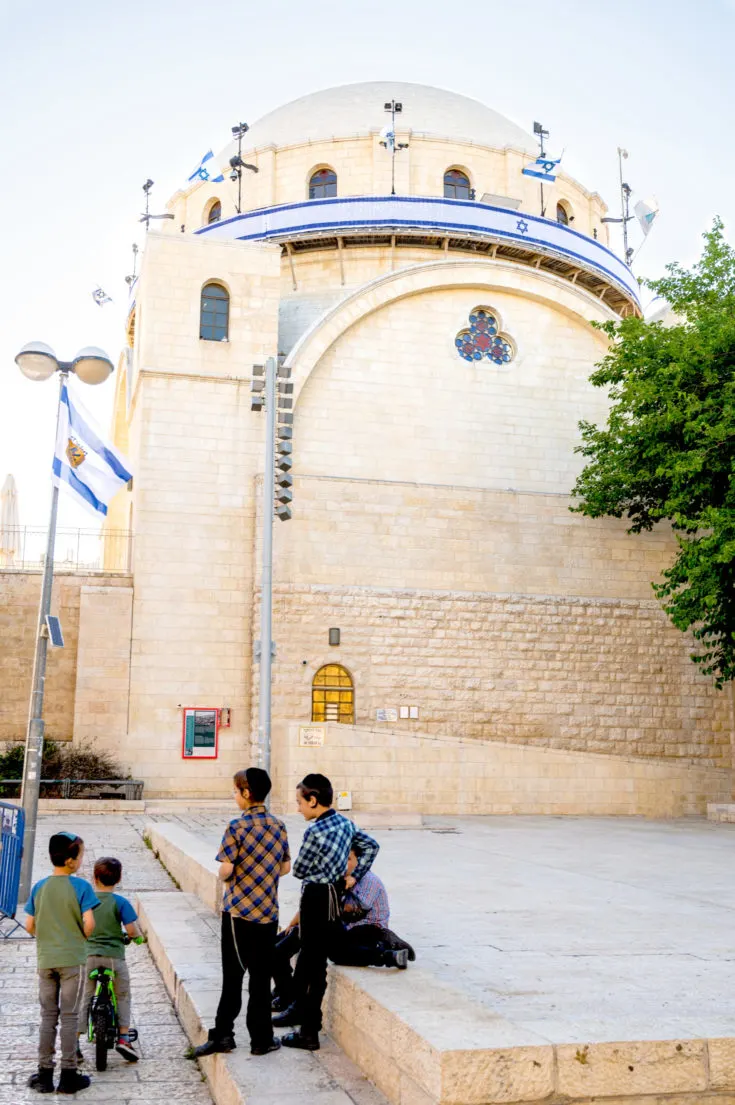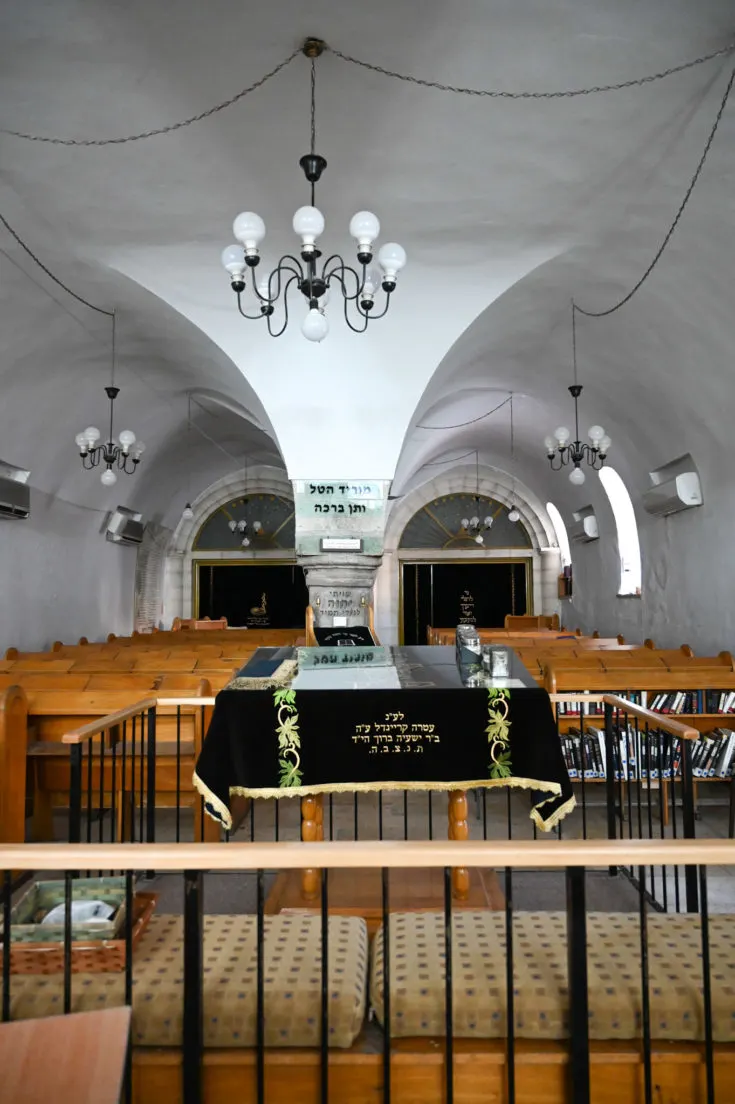Old City section of Jerusalem is the original ancient city of Jerusalem, while the rest of Jerusalem is the modern city which has spread far and wide outside the cities walls.
The modern sections of Jerusalem are due to Sir Moses Montefiore’s efforts to settle outside of the protective Old City walls. The first neighborhood was Mishkenot Sha’ananim.
Today, the Old City is divided into four quarters: the Jewish Quarter, the Christian Quarter, the Armenian Quarter, and the Muslim Quarter.
Jewish Quarter
The Jewish Quarter is filled with ancient holy and archaeological sites like the Jerusalem Archaeological Part.
Here you can find religious sites like the Western Wall and the Temple Mount.
You can also visit synagogues that are centuries old like Hurva Synagogue and the Four Sphardic Synagogues.
Not to mention, ancient secular sites like the Cardo.
Armenian Quarter
The Armenian Quarter was started when Armenian monks settled in Jerusalem in the 4th or 5th century.
While the Armenian Quarter is generally not a major tourist destination, Jaffa Gate is the main entrance to the Old City and is located there.
Right past Jaffa Gate are the most popular attractions in this quarter: the Tower of David Museum and the entrance to the Ramparts Walk.
Also, there are many shops and restaurants along the way from Jaffa Grate to the Muslim market and along the path to the Jewish Quarter.
Pro Tip!
It’s best to go through the Armenian Quarter to get to the Jewish Quarter and the Western Wall.
While you can cut through using the Muslim shuk, it is narrow and packed with people.
Instead, follow the road right through the Armenian Quarter until you reach the Jewish Quarter.
Christian Quarter
The Christian Quarter is home to Christian Arabs though it contains few houses and mostly religious tourists and educational buildings.
This quarter is where the Church of The Holy Sepulchre is located.
Muslim Quarter
The Muslim Quarter is mostly is mostly known for the shuk (market) and that the beginning of the Via Dolorosa. It also has many Roman and Crusader remains and is where the Way of Sorrows is located.
The Muslim quarter had a mixed population of Jews, Christians, and Muslims until the 1929 Palestine riots.
Today there are still about 60 Jewish families, The Ohel Yitzchak Synagogue, and Yeshivat Ateret Yerushalayim located in the Muslim Quarter.
Old City Walls
The Walls of Jerusalem surround the Old City of Jerusalem. Over the past 3000 years, they’ve been built and rebuilt a number of times.
Ancient
The City of David on Mount Zion was the first walled city of Jerusalem, beginning about 3,00 years ago.
Then, King Solomon built the First Temple on the hilltop rising right above the city he had inherited, today known as the Temple Mount, and then extended the city walls to include it.
The entire city was destroyed in 587 – 586 BCE during the siege led by Nebuchadnezzar of Babylon.
After the Babylonian captivity and the Persian conquest of Babylonia, the Jews were allowed to return to Judea and rebuild the Temple and the cities walls.
Josephus refereed to this as the First Wall.
The First Wall
During the Second Temple period, especially during the Hasmonean period, the city walls were expanded and renovated.
It encompassed Upper City and Lower City, which is today the Armenian and Jewish Quarters.
From there the wall turned east and north on the eastern side of the City of David along a line parallel to Nahal Kidron and was built above the ravines.
From there the wall descended along the southern ridge line of Mount Zion, toward the Shiloah Pool, and then passed through the Ophel and joined the Temple Mount wall.
The section near the Tower of David later served as a base for the Ottoman wall and the remains of it still exist.
The Second Wall
As the city grew, it expanded north outside the First Wall Second Temple period.
In order to protect it, the Second Wall was built during Herod’s reign around the new neighborhoods and attached to the First Wall.
The route the wall is unknown and can only be presumed due to the lack of descriptions and discoveries at this time.
All that is known for certain about it is:
“The Second Wall started at Gennath, a gate in the first wall. It enclosed the northern quarter only and went up as far as Antonia…” – Josephus
The Third Wall
There was yet again a need to expand outside the cities walls and became known as Bezetha, which means New Town in Aramaic.
The Third Wall was built at the end of the Second Temple period it was begun during the reign of King Agrippa I. However, Roman’s made him halted its construction.
It was continued by the Kannaim and was later hastily completed on the eve of siege of Jerusalem.
During the 1920’s remains of the Third Wall were accidentally discovered, which led to the beginning of the first scientific excavations of it.
In 2015 more remains were unearthed at the campus of the Bezalel Academy of Arts and Design.
Most of the Third Wall passed through the area of what is today the New City, in the Mussrara and Mea Shearim neighborhoods.
However, in 70 CE, as a result of the Roman siege during the First Jewish–Roman War, the walls were almost completely destroyed.
Jerusalem remained in ruins for some six decades until the pagan Roman city, Aelia Capitolina, was built in the ruined Jewish city of Jerusalem, 130 years later by Emperor Hadrian, but was at first left without protective walls.
After some two centuries without walls, a new set was erected around the city, probably during the reign of Emperor Diocletian.
Then, the walls were extensively renewed by the Empress Aelia Eudocia during her banishment to Jerusalem.
Medieval
In 1033, most of the walls were destroyed by an earthquake and it had to be rebuilt by the Fatimids.
However, they left out the southernmost parts that had been previously included: Mount Zion, the City of David, and the Jewish neighborhoods which stood south of the Temple Mount.
In 1219 Saladin’s nephew, Al-Malik al-Mu’azzam ‘Isa, had the walls torn down, mainly because he feared that the Crusaders would benefit of the fortifications if they managed to reconquer the city.
For the next three centuries, the city remained without protective walls, the Temple Mount and the citadel then being the only well-fortified areas.
Then Suleiman the Magnificent rebuilt the wall 1537 and 1541, and included four main gates facing towards the four winds: Jaffa Gate, Damascus Gate, Golden Gate, and Zion Gate.
The wall was built to fortify and glorify the city, to bring back free trade to its markets, and to maintain its security.
According to legend, when Suleiman saw that the architects had left Mount Zion, on which The City of David was located, and King David’s Tomb outside of the enclosure, he ordered them executed.
However, in deference to their impressive achievement, he had them buried inside the walls next to Jaffa Gate.
These are the walls that still stand today.
Old City Gates
The wall that encompasses the Old City of Jerusalem were built in layers, expanded and renovated many times in the course of history.
Today’s wall has been standing for around 480 years, and even though it is the newest of the city walls, it follows the route of the walls that have encompassed the city since ancient times.
There are seven open gates in the Old City and another five closed gates, all created at various points in time.
Jaffa Gate
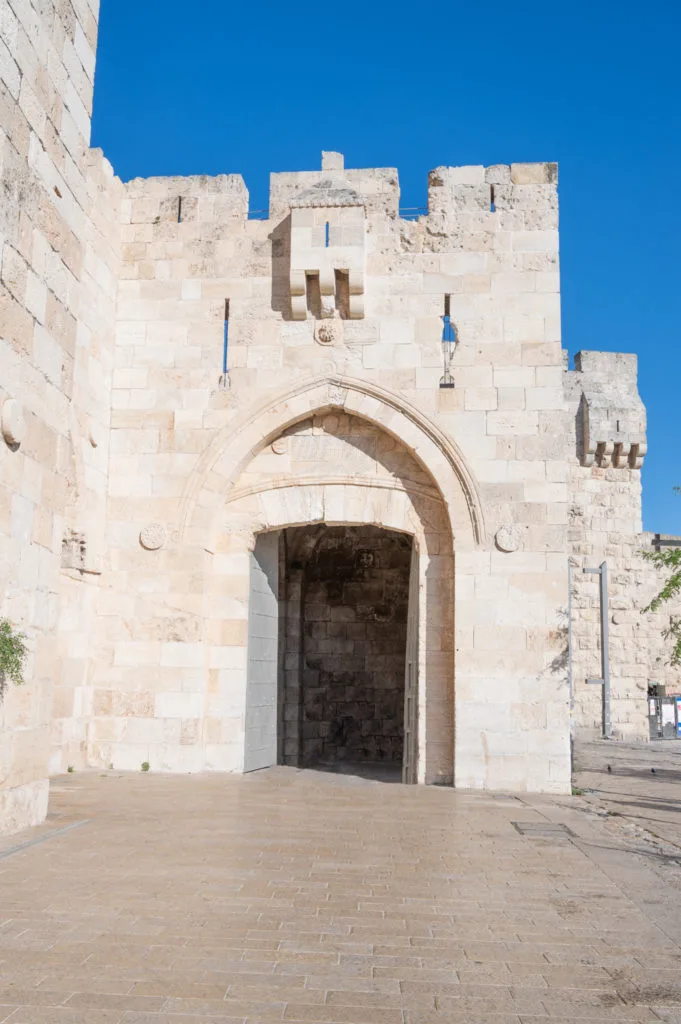
Jaffa Gate was completed in 1538 as part of the rebuilding of the Old City walls by Suleiman the Magnificent.
It is called Jaffa Gate because, as it does today, it is connected to Jaffa Road which in turn stretched all the way to the port in Old City of Jaffa. This way travelers and pilgrims took to the Old City.
The gate has the shape of a medieval gate tower with an L-shaped entryway which was secured at both ends with heavy doors. This shape was a classical defensive measure designed to slow down oncoming attackers.
Next to the Gate is a large breach in the wall was created in 1898 by the Ottoman authorities in order to honor German emperor Wilhelm II who came through them.
The demolished wall segment moved to citadel moat, a portion of which was filled in, to create a ramp.
The breach and the ramp leading up to it are now allowing cars to access the Old City from the west.
Jaffa Gate is one of the gates of the Old City and the most commonly used entrance due to it’s proximity to Jaffa Road.
Zion Gate
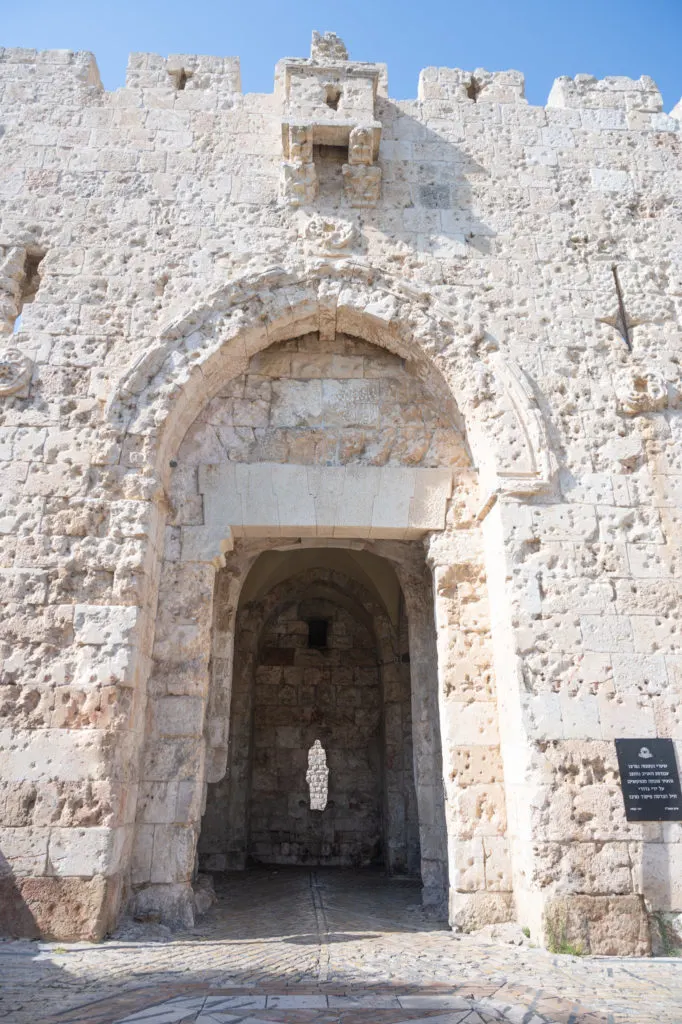
Zion Gate, also know as King David’s Gate, was built by the Ottomans as a direct continuation of the Street of the Jews also known the Cardo and leads to Mount Zion.
Six sentry towers were erected in the southern segment of the wall, four of them situated in the Mount Zion section.
On May 13, 1948, as the British Army withdrew from Jerusalem, a major from the Suffolk Regiment presented Mordechai Weingarten with the key for the Zion Gate.
The bullet holes on the facade of the gate are remnants Israel’s War of Independence that took place later that year.
Mount Zion which located next to Zion gate is where you will find the closest parking space to the Jewish quarter and the Western Wall for non-residents.
Enter the gate and walk to your right, downhill towards the Jewish Quarter and the Western Wall an approx 5-10 minute walk along the southern Walls of the Old City.
Lions Gate
Loins Gate gets it’s name by the four lions carved into the wall above it, two on the left and two on the right. It is located in the Muslim Quarter.
Legend has it that Suleiman’s predecessor Selim I dreamed of lions that were going to eat him because of his plans to level the city. He was spared only after promising to protect the city by building a wall around it.
Above the lion embossments there are additional decorations: flowers and arches are embossed between the embrasures, and above them an inscription that commemorates the construction of the city’s wall by Suleiman the Magnificent.
On the upper part of the gate a terrace stands out, known as a “Mashikoli”. From this small terrace one can observe the outline of the wall, and possibly spill hot oil on intruders.
Originally, it was an L-shaped gate, like Jaffa gate, to protect the city from innovators, today it is a straight gate that enables the entrance of vehicles.
During the Six-Day war in 1967 the IDF paratroopers entered the city via this gate on their way to the Temple Mount and reunification of Jerusalem.
This gate is also the start of the traditional Christian observance walking down the Via Dolorosa begins at the Lions’ Gate.
Dung Gate
The name Dung Gate comes from the mistranslated from the which would be Trash Gate which appears in the Book of Nehemiah.
It is probably named after the residue that was taken from the Jewish Temple into the Valley of Hinnom, where it was burned.
This ancient “Dung Gate” may not have been in the same location as the today’s gate.
This was the entrance to the Old City and the Western wall used by Israeli soldiers during the Six-Day War when Jerusalem was reunified in 1967.
The gate was built as a small postern gate by the Ottomans designed for pedestrians and pack animals to pass through. However, it was widened for vehicular traffic in 1952 by the Jordanians, and again in 1985 by Israel.
Those who enter from the Dung Gate could see at their right the “Archeology Garden- the Davidson Center”, an impressive archeology site that presents the remnants of Jerusalem from different eras, especially from the times of the Second Temple.
Damascus Gate
Damascus Gate, or the Nablus Gate, connects to a highway leading out to Nablus, and from there, in times past, to the capital of Syria, Damascus. The gate was built by Suleiman the Magnificent.
This gate leads into the the Muslim and Christian Quarters and has easy access to the Jerusalem light rail.
Directly below the existing gate of is an older gate dating back to the time of the Roman Emperor Hadrian. In front of which was once a Roman era, a stone-paved courtyard , and at its center stood the statue of the emperor.
Hadrian’s Gate
While Hadrian’s Gate (which as no official name) was the main gate to the city during the Roman and Byzantine rule, today it leads to the Roman Plaza Museum.
Hadrian’s Gate was built as a free-standing triumphal gate.
The central arch was some 40 meters wide and about 20 meters tall with identical, more modest, entrances to the city on either side.
It was here that anyone passing through the gate into the city, which was a paved road, would need to pay taxes to enter.
In the square behind the gate stood a Roman victory column topped by a statue of Emperor Hadrian. This can still be seen depicted on the 6th-century Madaba Map located in the Cardo.
This gate was the smaller entrance that stood on the right.
On the lintel of this gate is inscribed the city’s Roman name after 130 CE, Aelia Capitolina.
Until the latest excavations some researchers believed that Hadrian’s gate was preceded by one erected by Agrippa I as part of what Josephus called the Third Wall.
The Roman gate remained in use during the Byzantine and Crusader periods.
Its side entrances were blocked during the Byzantine and Early Arab periods.
Later the Crusaders built a new, fortified gate at a much higher level, unwittingly preserving the remains of the Roman gate below it.
Herod’s Gate
Herod’s Gate, or Flowers Gate, is one of the newest gates of Jerusalem, built in 1875, which opens from a wall tower. While it is simple, it has floral design near the top of the gate.
The gate’s name was derived from a mistaken belief held by pilgrims that a nearby building was at one time the palace of Herod Antipas.
At the time when Suleiman the Magnificent built the city walls, it was just a a small wicket gate and rarely opened.
Formerly, area gate led to the residential known as Bezetha, or “New City,”, settled during the late Second Temple period to accommodate Jerusalem’s growing population. Today this area is the Muslim Quarter.
At the time when Suleiman the Magnificent built the city walls, a small wicket gate was situated in the eastern, lateral wall of the tower, which was rarely opened.
By 1875, in order to provide a passageway to the new neighborhoods which were beginning to develop north of the Old City, the Ottomans opened a new gate in the northern, frontal wall of the tower closed the original lateral gate.
Gate of Mercy
The Gate of Mercy, known by Christians as the Golden Gate, is the only original gate leading to the Temple Mount and one of only two that used to offer access into the city from that side.
The gate has been walled up since medieval times. However, the date of its construction is disputed and no archaeological work is allowed at the gatehouse, but opinions are shared between a late Byzantine and an early Umayyad date.
In the Mishnah (Middot 1:3), the eastern gate of the second Temple compound is called the Shushan Gate.
If the Gate of Mercy does preserve the location of the Shushan Gate, this would make it the oldest of the current gates in Jerusalem’s Old City Walls.
According to Jewish tradition, the Shekhinah, or Divine Presence, used to appear through the eastern Gate, and will appear again when the Messiah comes (Ezekiel 44:1–3) and a new gate replaces the present one.
This might why Jews used to pray in medieval times for mercy at the former gate at this location.
Another possible reason being that in the Crusader period, when this habit was first documented, they were not allowed into the city where the Western Wall is located.
Hence the name “Gate of Mercy.”
Suleiman incorporated the gate into the wall he built around the city, but closed it 1541 and it has stayed that way.
One thought is that Suleiman may have taken this decision purely for defensive reasons.
However, since there is a Jewish tradition that this is the gate through which the Messiah, it is possible that he sealed off the gate to prevent a false Messiah coming through entrance.
The Ottomans also built a cemetery in front of the gate to prevent a false, Prophet Elijah – who is supposed to announce the arrival of the Messiah, from passing through the gate.
This is because, according to Islamic teaching Elijah is a descendant of Aaron, making him a priest or kohen, and knowing that a Jewish kohen is not permitted to enter a cemetery.
However, a Kohen is permitted to enter a cemetery in which either Jews or non-Jews are buried, such as the one outside the Golden Gate, as long as certain laws or Halakha regarding purity are followed.
New Gate
The New Gate was built in 1889 to provide direct access between the Christian Quarter and the new neighborhoods then going up outside the walls.
The arched gate is decorated with crenelated stonework. The New Gate was built at the highest point of the present wall.
It should not be confused with the New Gate of the Second Temple complex mentioned in the Book of Jeremiah that served as entrance to the Great Sanhedrin’s Hall of Hewn Stones, and was previously called the Benjamin Gate.
Tanners’ Gate
Tanners’ Gate is located near the Dung Gate in the Jewish Quarter. It is the second oldest entrance into the Old City.
Probably built in the 12th Century by the Crusaders near a cattle market – hence the name – as pedestrian gate.
Suleiman the Magnificant filled in Tanners’ Gate when he built the current Old City walls, gates, and towers.
The gate was discovered during archaeological investigations, partially reconstructed and interpreted as part of the Beth Shalom Garden.
It was studied further during excavations along the Old City walls in 1995. The Jerusalem Foundation supported archaeological excavation and restoration of the gate and construction of an adjoining plaza into the Old City.
The restored gate was the first new opening into the Old City walls since 1887.
What To Do in The Old City
The Temple Mount
The Temple Mount refers to the elevated plaza above the Western Wall that was the site of both the First and Second Jewish Temples. It is and always has been the holiest site in the world to Jews.
in the 7th century Muslims began viewing Jerusalem and the Temple Mount as a holy site. Today it is considered the third holiest sites to Muslims, after Mecca and Madina.
At the end of that century the shrine known as the Dome of the Rock was built on the Jewish holy site shortly and Al Aqsa mosque was as well shortly there after.
Non-Muslims are permitted to visit the plaza during set days hours. However they are not allowed to enter the Dome of the Rock.
Western Wall (Kotel)
The Western Wall or the Kotel, is the last remaining wall of the Second Temple. It is revered as a holy site because it is the closest to the Temple Mount Jews are legally allowed to pray.
In addition to Jews, many Christian tourists also come pray at at the wall.
Prayers there include regular Jewish prayers that are said three times a day, saying Psalms, and personal heartfelt prayers.
It is also tradition to leave a note asking G-d for things. These can be anything your heart desires, big or small.
Western Wall Tunnels
The Western Wall Tunnels offer a tours that follow tunnels under ground, between the houses of the Jewish Quarter and the Western Wall Plaza, and extends to the end of the wall under the Muslim Quarter.
The site contains unique archaeological findings from many periods of Jerusalem’s 3,000 years of existence.
This includes evidence of Jewish settlement and government from the First Temple, 2,700 years ago.
This guided tour will bring your through archaeological sites, give historical information and context of discoveries found there.
The Jerusalem Archaeological Park
The Jerusalem Archaeological Park and Davidson Center are located nearby the Western Wall in the Old City.
The park contains artifacts from different periods: the First and Second Temple periods, the Byzantine period, Muslim period, the ancient Crusades period, as well as others.
The most exciting findings are: the walls of the city from the First Temple period, the steps leading up to the Temple, the original street from the time of the Second Temple period, shops, ritual baths, and more.
However, you can also walk the streets and climb the stairs pilgrims to the Temple Mount did 2,000 years ago.
The Davidson Center is a museum within the archaeological park, with presentations and exhibitions related to findings from the site.
In addition, a virtual model with local guidance will take you back in time to the days of the Second Temple.
With it, you can and walk with pilgrims on the street, buy a sacrifice, immerse yourself in the mikveh, and ascend to Temple Mount.
The Herodian Quarter
The Herodian Quarter is a museum that exists under the Jewish Quarter. Here you can see ancient houses, ritual baths, and housewares which belonged to priests who worked in the Temple.
Chamber of the Holocaust
Technically, the Chamber of the Holocaust is built just outside the Old City, however, it is a must see.
This was the the world’s first Holocaust memorial and is a powerful yet little known museum by Israelis and tourists alike.
It was built as a symbolic cemetery, as a place for Holocaust survivors to cry and mourn for their families, especially if they didn’t know where their loved ones were buried.
Built in a Crusader dungeon, the chamber was a place for survivors and victims’ descendants to light memorial candles, recite the Kaddish, remember, and mourn.
Today, it is a museum and the objects, on display were donated by Holocaust survivors and victims’ families as a memorial to those who perished.
Ramparts Walk
Ramparts Walk offers a unique view of the city of Jerusalem from atop of the Old City walls.
For centuries soldiers walking along the walls’ ramparts, patrolling between the gates and guard towers.
However, in recent years, the path has been renovated and turned into a promenade offering a unique view of Jerusalem inside and outside the walls.
The Tower of David
The Tower of David Museum of the History of Jerusalem is located in the medieval citadel known as the Tower of David.
The Museum presents Jerusalem’s story. It details the major events in its history beginning with the first evidence of a city in Jerusalem in the second millennium BCE, until the city became the capital of the State of Israel.
In addition, the Citadel itself is a fascinating archaeological site and offers a virtual reality tour.
The Burnt House
The Burnt House, also known as Katros House, is a museum presenting an excavated house from the Second Temple period.
The house, was found under a layer of ashes and destruction, indicating that the house had been burned down. It was the first evidence found of the total destruction of the city by the Romans.
In the museum, you can walk through rooms that are virtually intact with artifacts from the time of the Second Temple.
Roman Plaza Museum
The Roman Plaza Museum is located on the remains of the Roman plaza at the entrance of Aelia Capitolina under the Damascus Gate.
The Museum shows the history of Damascus Gate, displays remains of a Roman plaza and gate dating back almost 2,000 years
Zedekiah’s Cave
Zedekiah’s Cave, or Solomon’s Quarries, is a vast cave that runs under the Old City of Jerusalem.
This cave is said to be where King Zedekiah the escape from the Chaldeans and where King Solomon got the Jerusalem stone to construction of the First Temple.
Herod also used it for building blocks in the renovation of the Temple and its retaining walls, while Suleiman used it to build present walls around the Old City.
It was once the largest quarry in ancient Jerusalem and runs under the Jewish and Muslim Quarters of the Old City of Jerusalem, stretching from Jeremiah’s Grotto to the walls of the Old City.
Old Yishuv Court Museum
The Isaak Kaplan Old Yishuv Court Museum tells the story of the inhabitants of the Old Yishuv, displayed through their original belongings, objects, and tools.
It also tells of the struggles they had to face; stories of birth and marriage, happiness and sadness, and faith in God.
The museum depicts the period decor and aspects of daily life in the Jewish Quarter from the mid-19th century to the end of the Ottoman rule just after World War I.
Plugat Hakotel Museum
The Plugat HaKotel Museum tells the seldom mentioned story of the Western Wall Platoon, a group of 24 young men and women who risked their lives to keep a Jewish spark alive at the Western Wall.
Through the museum, located in the heart of the Jewish Quarter, together with other Zionist museums in Jerusalem, you can learn of historical Zionism beginning.
Museum visitors will begin the tour with the story of the shofar and will continue to stories of the heroism of the Irgun members who were brought up on the same values instilled by the platoon.
Jewish Quarter Defender's Memorial
Jewish Quarter Defender’s Memorial features rare images which capture the last days before the fall of the Jewish Quarter in 1948.
It also has short video where residents and fighters recall their experiences from those dramatic moments.
Thirty-nine fighters and thirty residents of the Jewish Quarter fell in the War of Independence.
Forty eight of them were buried in a mass grave where the Gal-Ed memorial monument now marks, Batei Machseh Square.
Little Western Wall (HaKotel HaKatan)
The Little Western Wall, also known as HaKotel HaKatan, is a Jewish religious site located in the Muslim Quarter,
While the famous section of the Western Wall is close to the south-west corner, it is actually 488-metre, or 1,601-feet long.
This smaller section is located more in the center of the wall, located approximately 170 meters north of the Prayer Plaza. However, the houses of the Muslim Quarter conceal most if of leaving only a small part exposed.
It is located near the Iron Gate to the Temple Mount and almost exactly faces where the Holy of Holies was giving it religious importance.
The Hurva Synagogue
The Hurva synagogue was constructed in 1864 in what was known as the courtyard of the Ashkenazim.
It became the most important synagogue for Ashkenazi Jews living in the old city. However, it was destroyed by the Jordanian Legion forces during the fall of the Quarter Israel’s War of Independence.
The Hurva Synagogue was re-inaugurated 62 years after its destruction in March of 2010.
Four Sephardic Synagogues
The Four Sephardic Synagogues are interconnected and served as the center of the Old City’s Sephardic Community.
Yochanan ben-Zakai and ELiyahu Ha-Navi Synagogues were established first. Later the Kahal Zion and the Istambuli Synagogue, build by Turkish Jews.
During the war of independence, many of the Quarter’s residents sheltered here. After the Six Day War, the Four Synagogues were renovated and prayer was established.
Ramban Synagogue
The Ramban Synagogue, is the second oldest active synagogue in the Old City.
It was founded by the scholar and rabbi Nachmanides, otherwise known as Ramban, in 1267.
The City of David
The City of David is the most ancient part of Jerusalem and is only a short walk from the Western Wall.
It was created by King David began over 3,000 years ago.
Today, this ancient city is a national park and the most important archaeological site in Israel. It has some of the most exciting archaeological finds of the ancient world.
The main area that has been arranged for visitors is on the south side of the Old City near the Dung Gate.
The Broad Wall
The Broad Wall is an archaeological site that was once Jerusalem’s protective wall during the First Temple period and one of the most important discoveries uncovered in Jerusalem.
Until the discovery of the wall, many scholars believed that the capital of the kings of Judah until the destruction of the Temple was only in the limited area of the City of David.
However, the discovery of the wall in the 1970’s reveled that the city had expanded to include the hill to the west of the Temple Mount.
This proved that the Kingdom of Judea was in fact much larger and greater than previously thought.
Israelite Tower
The Israelite Tower is an archaeological site that was a significant find since it testifies to the size and strength of Jerusalem during the First Temple period.
The tower is a significant find since it testifies to the size and strength of Jerusalem during the First Temple period.
It also is evidence of Jerusalem’s destruction at the hands of the Babylonians.
HOLY TEMPLE MUSEUM
The Temple Institute is recreates items that were a necessary part of worship in the Jewish Temple.
These items are on display at the Holy Temple Museum, including High Priests garb and 60 sacred vessels created in accordance with biblical requirements.
Also on display is a gold and marble model of the second temple.
AISH HATORAH CENTER
Aish Center overlooks the Western Wall from across the Plaza. They host thousands of visitors annually to free religious lectures given daily, as well as their Discovery Seminar.
The Center is also home to a 1.2-ton model of the Holy Temple which sits on the rooftop terrace overlooking the site where the real Temple once stood.
The model is the largest of its kind, constructed at a scale of 1:60. It also incorporate authentic materials like gold, silver, wood, and Jerusalem stone.
In addition, it features a system that raises the sanctuary section of the Temple. This offers an internal view of key elements such as the Holy of Holies, the Menorah and the Ark of the Covenant
